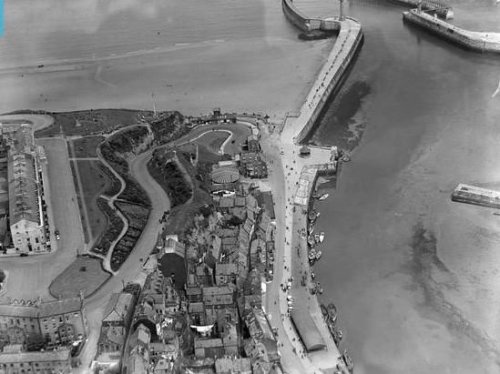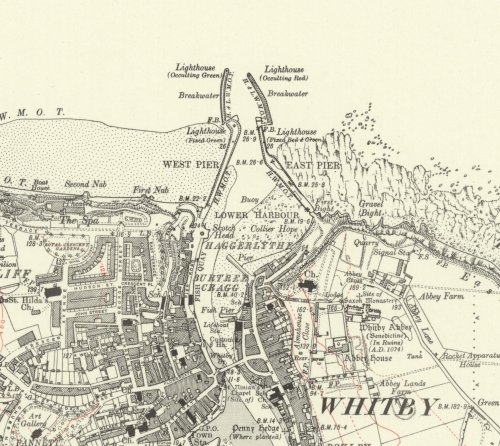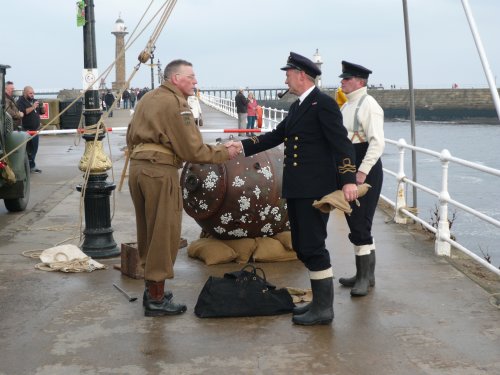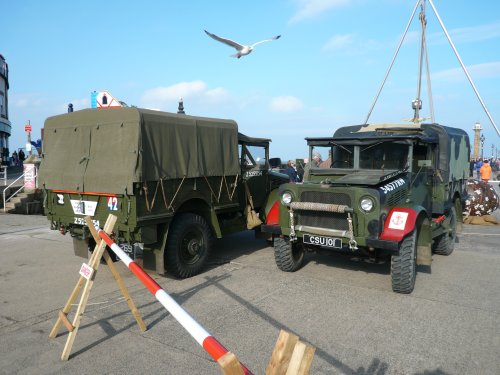| As part of the Pickering wartime weekend in 2016, we decided to repeat our successful demonstration showing how a Royal Navy Mine Clearance Party recovered and rendered safe a German contact mine which had washed ashore just inside Whitby
Harbour.
During WW2, most combatants used sea mines. These could be used defensively by laying them in declared minefields which acted as a barrier and resulted in enemy ships having to avoid these areas or find alternative routes before they could attack our convoys or ports. They could also be used offensively. Fast minelayers, submarines or E-boats would regularly speed across the channel at night and sow their deadly cargoes of mines across shipping channels or harbour entrances hoping to catch the unwary the next morning. |
 |
 |
Sea Mines were developed during the American War of Independence. Barrels of gun powder with slow burning fuzes were floated down river amongst British ships moored in
harbours. By WW2 the mine was far more sophisticated. Moored to the sea bed by a long cable attached to an anchor called a sinker, most were buoyant ‘contact’ mines. They required the target to physically make contact with the submerged mine to trigger an explosion. This was achieved by the mines’ horns. Earlier mines has brass or soft lead ‘Hertz’ horns that were easily bent when struck. This broke a glass tube inside releasing electrolyte into a dry battery and firing the detonator. Later mines had very sensitive switch horns which if moved a less than half an inch made an electrical contact and exploded the mine.
Large fleets of minesweepers had the tedious daily, but always dangerous, task of sweeping the sea channels clear of these mines. Most of these sweepers were crewed by men of the Royal Naval Reserve or Royal Naval Patrol Service. Peacetime fishermen drafted into the role by the necessity of war. The sweepers towed steel cutting cables that severed the mines mooring cables. Once freed the buoyant mines rose to the surface where sailors armed with rifles or deck weapons would destroy or sink the mines by puncturing their floating shell. |
| Occasionally during a rough storm the mine’s mooring cables broke and they drifted freely. A menace to all, drifting at the whim of the tides and winds. The good news was that all such mines were supposed to disarm themselves when freed of the cables. Once the pull of the cable was released, a large lever on the base was returned by a strong spring to the ‘off’ position and the mine wouldn’t explode unless the cable was snagged or pulled in some way. Unfortunately some older mines perhaps due to encrustation failed to deactivate. Even worse occasionally German mines were found with weights attached that prevent the levers return keeping them active and therefore a hazard to all shipping unfortunate enough to encounter them. Eventually it was these drifting mines, safe or not, that ended up on both ours and continental shores.
Regionally based naval mine clearance parties had the dangerous job of making safe the unexploded mines which washed up all along our coastline. Once a mine was reported the team would drive to the location and assess the situation. If an explosion was unlikely to cause damage, the detonating mechanism would be carefully removed and the remaining explosive charge in the mine burned on the spot. After about forty minutes of bright fireworks all that would be left was a pile of melted metal.
( Photograph 1 ). |
Photograph
1
 |
Photograph
2
 |
If however the mine washed ashore near property or strategically important locations the job became more difficult. After the Render Mines safe Officer has removed the horns, the detonator and the primer charge, the mine would be lifted or dragged to vehicles and removed to a safe location before being disposed of. Quite often these small parties would request the help of other local units to assist in this task.
This is what we were recreating at
Whitby, over seventy years after the war. Our mine had washed ashore during the early morning on the high tide and was perched on rocks just below the West pier near the old lifeboat station. A British Mk. XIV contact mine. The party arrived in a Bedford MW and Standard
Tilly. Both had the red painted front wings indicating they were assigned to bomb disposal teams.
( Photograph 2 ). |
| Local Coastal Battery Artillery unit was attached in a second MW to assist with lifting and handling the mine after it had been rendered safe.
( Photograph 3 ). It was a race against the incoming tide. Our arrival at 1200hrs was some hours after low water and the tide was now coming in quickly. There was a real risk the mine could be lifted by waves and become dangerous as it was pounded against the rocks.
Very quickly the vehicles drove onto the end of the West Pier, parked up and set up barriers to keep the public at a safe distance.
( Photograph 4 ). |
Photograph
3
 |
Photograph
4
 |
| Lieutenant Commander Boyle R.N.V.R. the Render Mines Safe Officer in charge of the party immediately descended down the side of the quay onto the rocks and began to check the mine over.
( Photograph 5 ).
C.P.O. Markham and P.O. Ford with help from the R.A. boys began to assemble the shear legs at the top of the pier, above the mine, ready to lift it from the rocks below once safe to do so.
( Photograph 6 ).
Photograph 5
 |
Photograph
6
 |
| With the rising water lapping around his ankles Lieutenant Commander Boyle checked the actuating lever was retracted and held in the safe position with a pin he carries for this purpose. He then successfully removed the mines screw in cap and cut the leads to the detonator exposed inside. This was carefully withdrawn and placed in a wooden case away from the mine. The using the special tool the primer charge was removed too. Finally the Hertz horns were quickly removed.
Now the ropes lowered by the party above could be attached to the mine case with its inert explosive charge case inside.
( Photographs 7, 8 ). |
Photograph
7
 |
Photograph
8
 |
Photograph
9

Holding carefully onto a stabilising line the Commander called ‘Haul away’ to the party above who pulled on the line to lift the heavy mine up towards the quayside. With much effort and additional assistance from the two WRNS drivers the mine came level with the railing above and was pulled inshore away from the drop.
( Photographs 9, 10, 11 ). |
Photograph
10
 |
Photograph
11 |
Once the mine was safely stabilised on the quay the Commander dismissed his party for a well earned tea break. Whilst they were gone with the assistance of C.P.O. Markham he checked the mine over to ensure it was safe to be loaded onto the vehicle and transported to a remote beach for disposal.
( Photographs 12, 13, 14, 15, 16 ). |
Photograph
12
 |
Photograph
13
 |
| The
Mine ready to be transported to the beach.
Photograph 14
 |
Photograph
15
 |
Photograph
16
 |
Tea break over the team set to redeploying the shear legs and carefully loading the mine into the back of the Bedford light truck.
( Photographs 17, 18, 19 ).
A final handshake and the artillery boys departed back to their coastal battery.
( Photograph 20 ).
The naval team drove away, taking the mine to a remote location further down the coast where it was destroyed with an explosive charge. This one wouldn’t be a danger to ships ever again.
( Photograph 21 ). |
Photograph
17
 |
Photograph
18
 |
Photograph
19
 |
Photograph
20 |
Photograph
21
 |
Tony Boyle's
Crew
 |
 |